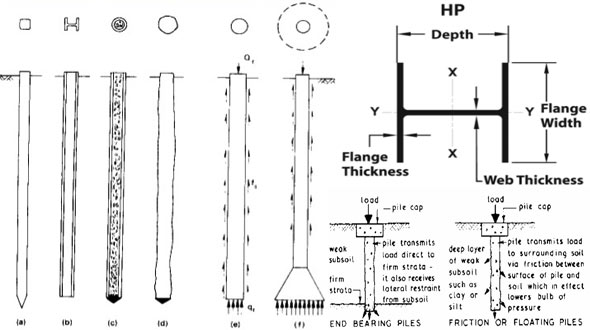Different types of piles and their functions
- Concrete Cost Estimator
- Concrete Continuous Footing
- Landscape Bidding and Estimating
- Construction Cost Estimating
- Concrete and steel cost estimation
- Construction Cost Estimate Breakdown
- Construction Estimating Worksheet
- Home Construction Cost Estimate
- Estimate Pricing Sheet
- Sheet for General Contractor
- Construction Cost Estimate
- Labor Materials Cost Estimator
- Masonry Estimating Sheet
- Sheet for Building Contractor
- Construction Schedule Bar chart
- General Cost Estimator Sheet
- General Construction Estimate
- Building and Road Estimating Sheet
- Detailed expense estimates
- Door and Window Takeoff Sheet
- General Construction Cost Estimating Sheet

On the basis of material type, configuration, installation method and the apparatus utilized, piles are classified in two main types: load bearing piles and sheet piles.
Different types of load bearing piles are available. Load bearing piles are again categorized depending on their method of load transfer from the pile to the soil mass. Load transfer is performed with friction, toe bearing or a combination.
Concrete Piles:
1. Concrete piles employ concrete as the primary structural material for compressive loads; although, concrete lacks to withstand tensile load. So, when a concrete pile is dependent on direct tension or bending, steel should be included to withstand these stresses.
2. Concrete piles are categorized as pre-cast or cast-in- place based on the manufacturing process. Pre- cast piles are built up in a casting bed, cured, and then pushed into place.
Steel Piles:
1. Amid all piling materials, steel piles have greater tolerable unit working stresses, but not essentially the utmost in relation to the ultimate strength of the material.
2. Steel piles are normally treated as high capacity piles but have been traditionally applied to deal with a wide array of loadings.
Steel H-Piles:
a. H-piles are specifically created sub-group of wide flange shapes having equivalent thickness in the web and flanges.
b. The depth of the section is roughly similar to the width. H-piles are hot rolled from ingots on the similar type mill applied to manufacture wide flange structural shapes.
c. These are flexible and utilized for both friction and end bearing.
d. They are developed as a finished product, which are pushed with standard equipment.
e. They are effective for a design load among 80 kips (356 kN) and 500 kips (2224 kN).
f. They are mostly suitable for end-bearing or partial end- bearing.
g. They are frequently used in several states for highway bridge piers and abutments where the job sites are situated in remote locations.
Benefits:
a. They have extreme individual load strength when pushed to bear on or in rigid or solid materials.
b. They are easily accessible and set up with standard driving equipment. The lengths can be easily stretched or curtailed as per the job requirements.
c. Compact shape with low displacement – They does not create any trouble to adjoining piles or structures. They can be easily set up where many other types fail to do so.
d. They contain extreme bending strength for being utilized with lateral loads. They can be easily pushed on a batter if necessary.
e. Good tension piles for uplift – constant cross- section, plus steel is most suitable material for tensile strength.
H-Piles as End-Bearing Piles:
a. H-piles are mostly suitable when they are pushed to refusal or practical refusal on rock, or into solid materials covering rock. The pile acts as a short column, thus the rock may contain good strength as compared to the steel for the maximum design load that is used.
H-Piles as Friction Piles:
a. When several meters of H-piles are pushed for friction applications, they stand for non-displacement piles and tend to be pushed further in loose sands and silty sand. There are good reasons however to opt for H-piles for this use if, for instance, a considerable scour depth is calculated for a bridge pier abutment.
H-Piles as Soldier Beams:
a. H-piles are frequently applied as soldier beams for retaining walls. These retaining walls are either permanent or temporary for excavations and braced cuts.
b. Normally, the H-piles are pushed on 6’ – 8’ (1.8 – 2.4 m) centers in a row containing the flanges facing each other. The lagging – either concrete or timber – is then fixed with the ends of the flanges facing the webs. In this way, the flanges of the H-piles maintain the lagging.
c. Cross bracing (in the case of braced cuts) or tieback systems are applied to offer extra lateral support for higher walls or loads.
d. H-piles also are applied in combination with sheeting to develop high-modulus walls.
To gather information on different other types of piles, go through the following link www.pilebuck.com/

- Application of concrete calculator
- Roofing Calculator can streamline the roof estimating process
- House construction cost calculator
- Engineering column design excel spreadsheet
- Material Estimating Sheet with Excel
- Materials List and Cost Estimate Worksheet
- Concrete Slab Estimating Calculator Sheet
- Common types of foundations for buildings
- Online calculation of construction materials
- Estimating with Excel for the Small Contractor
- Concrete Beam Design Spreadsheet
- Virtual Construction Management app for construction
- Autodesk’s Project Skyscraper
- Reed Construction’s Reed Insight
- Manage your construction project documentation
- Costimator, the popular cost estimating software
- On Center Software for construction professionals
- Free Construction Estimating Software
- Plumbing Calc Pro
- Cost Estimate Worksheet
- HVAC Piping Quantity Takeoff Worksheet
- Construction Estimating Software Sheet
- Estimate Cost Templates
- Construction Punch List
- Construction cost estimating template consisting estimating basic
- Gantt Chart Template for Excel
- Download Civil Engineering Spreadsheets with Verification
- The Building Advisor Estimating and Budgeting Worksheet
- Spreadsheet for design of concrete bridge
- Construction Estimating Software Free








